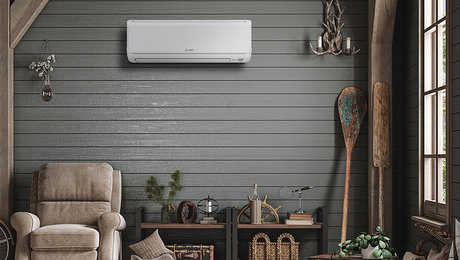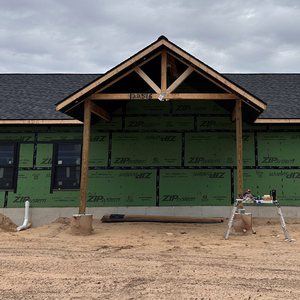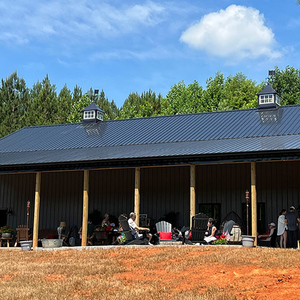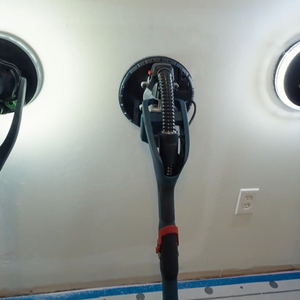I’m enlarging the bathroom in a small apartment into an adjoining hallway, and will need to relocate the breaker box. It’s actually a sub panel- at the service entrance, there’s a panel with a pair of 60A breakers which feeds this panel. I understand the basic idea is to install a large junction box, then run as many new wires as necessary from there to the new panel location. This will be around 10 to 12 branch circuits, along with the main 60A 220 feeders. Can all these splices be in the same box? Is 4/3 w/ground NM cable (for the mains) readily available? Is it OK to just use as many NM cables as necessary?
Discussion Forum
Discussion Forum
Up Next
Video Shorts
Featured Story

Choosing the right heating and cooling system means finding the best fit for your home's size, layout, and climate—and balancing trade-offs in efficiency, comfort, and cost.
Featured Video
How to Install Exterior Window TrimRelated Stories
Highlights
"I have learned so much thanks to the searchable articles on the FHB website. I can confidently say that I expect to be a life-long subscriber." - M.K.
Fine Homebuilding Magazine
- Home Group
- Antique Trader
- Arts & Crafts Homes
- Bank Note Reporter
- Cabin Life
- Cuisine at Home
- Fine Gardening
- Fine Woodworking
- Green Building Advisor
- Garden Gate
- Horticulture
- Keep Craft Alive
- Log Home Living
- Military Trader/Vehicles
- Numismatic News
- Numismaster
- Old Cars Weekly
- Old House Journal
- Period Homes
- Popular Woodworking
- Script
- ShopNotes
- Sports Collectors Digest
- Threads
- Timber Home Living
- Traditional Building
- Woodsmith
- World Coin News
- Writer's Digest


















Replies
One common approach is to use the existing panel box as a junction box. Just replace the panel cover with a blank cover.
Just make sure the junction box is accessible.Is there any way to reroute some of the older wiring? ie. if the branch circuits from the sub panel are coming from the direction where the new panel will be then make just remove and reuse these cables minimizing splices.
Thanks for the reply.Yes, I plan to move as many branch circuit wires as possible. What about the main feeder circuit? Can that be spliced in the same box as the branches? Is NM cable for the main feeder OK to use to run to the new panel location (60A)?Thanks
Thanks for the reply.Yes, I 'm aware of that technique, but the panel is only a couple of years old, and I think it would be cheaper to buy a new junction box than a panel.
Only if you live right. The problem is that the cables feeding the panel will be cut to length, and any smaller junction box will likely create difficulties with getting the cables to reach.
It is an ironic habit of human beings to run faster when we have lost our way. --Rollo May
Why would it have to be a smaller junction box? Don't they make large junction boxes; 12x12x3 for instance?
Yep, but the new box needs to be nearly the same size/shape as the old to avoid cable length problems, and still there's a signficant amount of labor involved in swapping the boxes.
It is an ironic habit of human beings to run faster when we have lost our way. --Rollo May
All cables come in from the top, so I think I'll be OK. Fortunately (or maybe unfortunately), my labor is free at the moment.
I agree with Dan, I think it would be easier to leave the panel in place and use it as a junction box. A new panel for your needs should not be that expensive. What type of panel do you currently have?You can get 4/3 NM-B cable. Go to an electrical supply shop. Another option would be to use SER (service entrance) cable to feed your subpanel. Check on the price difference. I think 3 conductor #4 SER cable is rated for 100 amps (dwelling) while 4/3 NM-B is only rated for 70. This would allow for a little room for growth, possibly (not sure what your situation is in your main panel).
Cutler-Hammer, but I was also trying to improve the appearance. Is there a standard flat cover available for most boxes? I was thinking I could have a junction box inside the wall with a flush plastic access panel covering it.
Not sure about replacing your panel door with some sort of blank cover...Cutler Hammer does make "decorator" covers for some of their panels, you may want to check their website. I have never used one, just seen them in the catalog. They mount on/over the panel door. i.e., you open the decorator cover, then open the panel door to get to the breakers.If you did this, my guess would be that you would have to fill the now empty breaker slots with knockout covers.
Main panel feeds this one via 3/4" conduit, so not easy to upgrade service in the future.
"You can get 4/3 NM-B cable. Go to an electrical supply shop. Another option would be to use SER (service entrance) cable to feed your subpanel. Check on the price difference. I think 3 conductor #4 SER cable is rated for 100 amps (dwelling) while 4/3 NM-B is only rated for 70. This would allow for a little room for growth, possibly (not sure what your situation is in your main panel)."First you need 4 WIRE, not 3. This is for a sub-panel and needs an isolated ground.#4 SER is not rated for 100 amp for residential use.It is rated for 100 amps for single family service and feeders that carry "service loads".Amd to the OP.You can't feed this from 2 breakers in the main panel. You need ONE 2 pole breaker..
.
A-holes. Hey every group has to have one. And I have been elected to be the one. I should make that my tagline.
"First you need 4 WIRE, not 3. This is for a sub-panel and needs an isolated ground."Sorry, that is what I meant... 3 conductor w/ ground."#4 SER is not rated for 100 amp for residential use.""It is rated for 100 amps for single family service and feeders that carry "service loads"."My recommendation for SER was based on the assumption that this was a home. Reading the first sentence of the OP I now see my brain fart. I do not have any experience with multi-family.Is SER allowed in this situation? At a lower amperage?Thanks for the corrections.
Yes, ser can be used a feeder or branch circuit. It is commonly used for electric stoves.But, even when used in that application the special ratings in 310.15(b)(6) don't apply.They only apply when it carries what is basically the whole service current. The code reconzes that the demand is usually much less than the full service rating..
.
A-holes. Hey every group has to have one. And I have been elected to be the one. I should make that my tagline.
Edited 7/23/2008 9:57 pm by BillHartmann
Not trying to threadjack here, but I'm not sure I follow.How does that not apply here? He will be feeding this subpanel from his main disconnect and 310.15(6) reads "For application this section, the main power feeder shall be the feeder(s) between the main disconnect and the lighting and appliance branch-circuit panelboards." It also looks like it says this is ok for multi-family (first sentence).Thanks again.
Looking at the full wording it does apply individual units in multi-family buildings.Looking at the code and the comments in the handbook it covers the service or feeders from the service disconnect.And the pictures in the handbook show individual meters either directly feeding the unit panel or a individual meters with individual disconnects and then each one feeding a unit panel.Technically that is not the case it. It oringinates from another panel.Probably upto the AHJ. My guess is that this a inlaw appartment or something like that. In which case it might not have a full set of appliacnes thus they might think the diversity is limited.Also can an dwelling unit only hav a 60 amp service. I know a standalong unit needs a minimum of 100 amp..
.
A-holes. Hey every group has to have one. And I have been elected to be the one. I should make that my tagline.
It's a small one-bedroom condo. Was converted to a condo in 2004, fully inspected and approved, so I guess 60A is OK. So, I'll install a new j-box where the old panel was, re-route as many of the old circuits as possible directly to the new panel location. The remaining ones, as well as the main feeders (#4s) will be spliced in the j-box to either NM or THHN in conduit to run to the new panel location. If I use THHN/EMT, can I run the feeders in the same pipe as the branch circuits (assuming proper pipe fill)?ThanksBill
If you run them in the same conduit, you have derating issues.